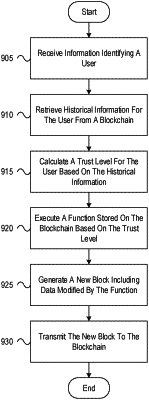| CPC H04L 63/102 (2013.01) [G06Q 10/06315 (2013.01); G06Q 20/10 (2013.01)] | 20 Claims |

|
1. A system comprising:
a blockchain computing platform comprising:
one or more first processors; and
first memory storing first instructions that, when executed by the one or more first processors, cause the blockchain computing platform to maintain at least one blockchain via a plurality of blockchain node devices; and
a computing platform comprising:
at least one second processor; and
second memory storing second instructions that, when executed by the at least one second processor, cause the computing platform to:
train, by a neural network, a plurality of neural network models to identify discrepancy information between supply chain input information corresponding to a first entity and that relates to a second entity, and second supply chain input information received from the second entity and that relates to the first entity;
identify, based on first information associated with the first entity, a first blockchain identifier of a first blockchain associated with the first entity;
retrieve, from a first block associated with the first blockchain identifier and from the first blockchain, first supply chain information comprising a smart contract and corresponding to a first supply chain associated with the first entity;
retrieve, from a second block from a second blockchain, second information comprising second supply chain information including a second blockchain identifier and corresponding to a second supply chain associated with a second entity associated with the second blockchain identifier;
retrieve, based on the first blockchain identifier, a timestamp associated with a block of the first blockchain storing most recent generated trust information;
calculate, when the timestamp is older than a threshold amount of time and by the neural network using at least one of the plurality of neural network models and based on the first information and the second information, a first trust level associated with the first entity and a second trust level associated with the second entity;
execute a function stored on the first blockchain, wherein the function comprises conditional logic based on at least one of the first trust level and the second trust level; and
cause generation, by the blockchain computing platform, of a new block on at least one of the first blockchain or the second blockchain, the new block comprising a data structure including data modified by the executed function.
|